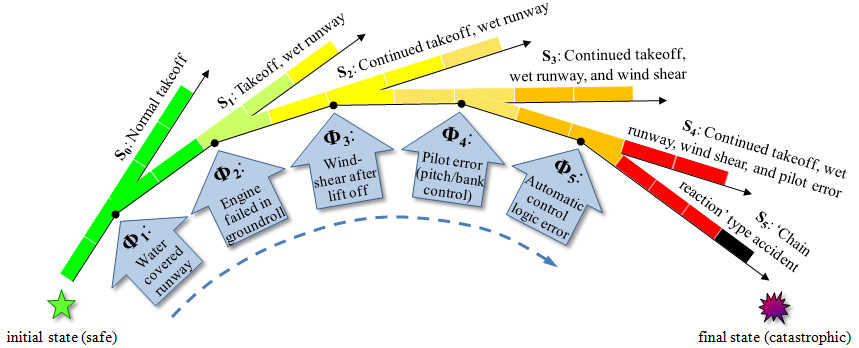Problem Statement
Major Operational (Risk) Factors Affecting Flight Safety
Legend: 1 – icing (effect on aerodynamics of wing, fuselage, and tail). 2 – rain (effect on vehicle aerodynamics). 3 – poor visibility, fog, nighttime, 4 – non-standard atmospheric conditions (temperature, pressure). 5 – demanding runway condition (dry/wet/iced), geometry, dynamics. 6 – obstacles (moving, stationary) or other kinetic safety threats. 7 – human pilot errors/inattention/tactics (objectives, observers, gains, etc.). 8 – wind (any 3D profile: gusts, crosswind, tailwind, wind-shear, microburst, rotor, wake, etc.), atmospheric turbulence. 9 – onboard software system logic/ data errors. 10 – onboard system mechanical failures (engines, controls, undercarriage, etc.). 11 – variations of aircraft configuration, weight, C.G. and inertia. 12 – flight control scenario variations, Pilot’s Manual errors.
NB: combinations of these factors are likely to cause flight accidents.
Multifactor Flight Accident Build-up Mechanism – Takeoff Example
Shortcomings of the Techniques Which are Used to Study
Multifactor Flight Domains
|
# |
Shortcoming |
Technique |
|||
|
A |
B |
C |
D |
||
|
1 |
Technical difficulty to setup and control the content of a multifactor flight research scenario – especially if a human pilot’s errors and/ or weather factors are involved. |
• | • | • | • |
|
2 |
The ‘curse of dimensionality’ – i.e. combinatorial constraints on the overall number and the content of multifactor flight cases that can be studied in overall. |
| • | • | • |
|
3 |
Difficulty to follow (and to repeat later with a modification) varying multifactor scenario sequences in every detail during flight test experiment/ simulation session. |
• | • | • | • |
|
4 |
Real-time flight experimentation capability only. |
| • | • | • |
|
5 |
A very high demand for resources – budget, time, human, material, etc. |
| • | • | |
|
6 |
Sparsely ‘exemplified’ flight test database on multifactor cases – especially during the early design, test and training phases of the vehicle lifecycle. |
• | • | • | • |
|
7 |
Difficulty to identify – reliably and in advance – anomalous scenarios and their pre-cursors for proactive safety risk management (now possible only after an accident). |
• | • | • | • |
Demand for ‘Dematerialization’ of Aircraft Flight Test, Certification, Operation and Pilot Training in Multifactor Situations
‘As with most aircraft accidents, there were several ‘ifs’ that might seem relatively benign when taken separately but together conspired to inflict substantial damage… and present a hazard to … people aboard. If the approach speed had been a few knots lower, if the touchdown has been a few meters shorter, if the runway had been dry and just a bit longer, if the pilots had considered a go-around a few seconds earlier, if the thrust reverser system had not malfunctioned, or if the concrete base for an approach light had not protruded from the ground off the runway, the … accident … might not have happened’.
[Mark Lacagnina, ‘A Matter of Meters’, AeroSafety World, The Journal of Flight Safety Foundation, April 2012, pp. 16-19].
‘The European Aviation Vision 2050… The European certification process, based on virtual simulation tools is widely applied at both component and product level and is streamlined, efficient and low cost. … Comprehensive and consolidated test, demonstration and validation infrastructures are harmonised, interoperable and available across Europe to support the transition to automated, autonomous and integrated systems and beyond. They include modelling, fast- and real-time simulation and flight-trial systems. These capabilities integrate the ground and airborne validation and certification processes. Education and training for controllers, pilots and engineers are incorporated into the system supported by training and simulation tools…’.
[Flightpath 2050. Europe’s Vision for Aviation. Report of the High Level Group on Aviation Research, European Commission, Directorate General for Mobility and Transport, Luxembourg, EC, 2011, 21 pp.].
| << Previous page | Next page >> |





